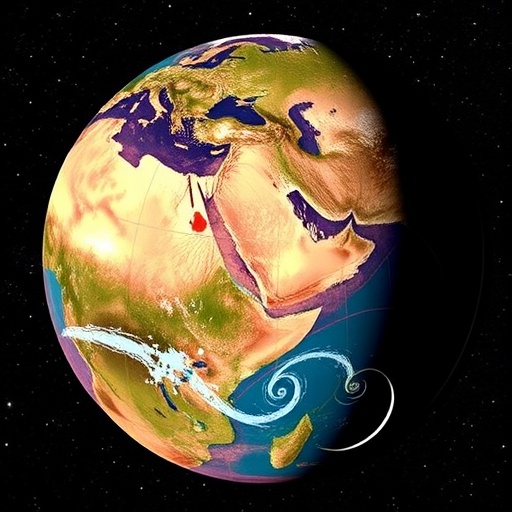Scientists have launched a groundbreaking initiative to unravel the mysteries of star formation within our Milky Way galaxy, constructing a highly detailed three-dimensional map derived from data captured by the European Space Agency’s Gaia space telescope. This innovative map provides a comprehensive view of star-forming regions, helping astronomers delve deeper into the intricate dynamics of these areas, which have long eluded thorough examination due to significant obstacles posed by obscuring clouds of gas and dust.
These clouds, which are densely packed with particles, obstruct direct observation of star formation sites, making the study of these areas particularly challenging. Traditional telescopes have struggled to penetrate these layers, leading to a limited understanding of the processes at play. Gaia, however, operates on a different principle, measuring stellar positions, distances, and the phenomenon known as ‘extinction’—a term that refers to the dimming of starlight as it passes through interstellar dust.
By analyzing the extent of extinction, Gaia enables researchers to map the distribution of dust and, consequently, to infer the presence of ionized hydrogen gas, a critical indicator of active star formation. The star-forming regions depicted in the new 3D model extend an impressive 4,000 light-years from the Earth, with our solar system positioned at the very heart of this spatial representation. This perspective sheds new light on the galactic landscape, revealing structures and components that had previously been obscured from view.
The map notably hinges on the analysis of both common stars and a unique subset known as O-type stars. These stars, characterized by their massive size and extreme brightness, serve as beacons for researchers. O-type stars emit significant amounts of ultraviolet radiation, which has a profound impact on their surroundings, ionizing nearby hydrogen gas. This ionization process is not merely a fascinating phenomenon; it facilitates the identification and classification of star formation regions throughout the galaxy.
Exclusive to this study, over 44 million common stars and 87 extraordinary O-type stars were scrutinized, providing an unprecedented dataset for constructing the three-dimensional framework of star formation sites. The sheer volume of data processed by Gaia not only enhances the accuracy of stellar positions but also draws correlations between various regions of the galaxy, unveiling a visually stunning and scientifically invaluable overview.
The implications of this research extend beyond just mapping. It promises to deepen our understanding of the physical mechanisms that govern the life cycles of stars and the conditions conducive to their birth. Significantly, astronomers remain captivated by how the immense gravitational forces at play and the energetic output of massive stars contribute to shaping the interstellar medium. This medium consists of gas and dust, providing the essential ingredients for further star formation, but also complicating the observational landscape for researchers.
The new 3D visualization distinctly illustrates complex structures, such as the Gum Nebula and the North American Nebula, allowing scientists to explore the dynamics of these stellar nurseries from various angles. The technological advancements and computational power harnessed to generate the map are monumental, involving intricate algorithms that synthesize vast amounts of data into coherent models. This effort unveils not only spatial relationships but also the energetic interactions occurring in these often chaotic environments.
One of the most exciting aspects of this map lies in the discovery that some clouds in the star-forming regions appear fragmented, hinting at dynamic processes that may be releasing gas and dust into a larger cavity within the interstellar medium. This detail provides essential insights into the spatial orientation and motion of material within the galaxy, painting a picture of a vibrant and evolving ecosystem.
Researchers emphasize the importance of these findings, asserting that Gaia’s comprehensive datasets will continue to be instrumental in advancing the field of astrophysics, paving the way for future studies that leverage the fourth data release from the satellite. The anticipation for subsequent data is palpable, as astronomers look forward to utilizing an even richer set of observations to further refine the mapping of star-forming regions and enhance our grasp of the Milky Way’s structure and dynamics.
In light of these revelations, the scientific community is invigorated with the possibilities that this new mapping technique presents—opening avenues not only for understanding the Milky Way but potentially for broader questions regarding galaxy formation and evolution across the universe. The pursuit to decode the complex behaviors of gases, stars, and environmental factors in star formation regions is sure to lead to more discoveries in the cosmos.
By developing this remarkable 3D view, astronomers are taking the first steps towards creating a reliable model of the Milky Way that approaches an objective reality, representing what our galaxy might resemble when viewed from an external vantage point. This foundational work will undoubtedly prove invaluable as it sets the stage for future explorations that aim to understand not only our galaxy’s past but also its future trajectory in a universe filled with endless wonders.
This remarkable undertaking, spearheaded by Lewis McCallum and his team at the University of St Andrews, stands as a testament to human curiosity and the relentless quest for knowledge that drives scientific inquiry. As the boundaries of our understanding continue to expand, we find ourselves ever more connected to the intricate dance of creation taking place within the vast, star-studded depths of our galaxy.
Subject of Research: Mapping Star Formation in the Milky Way
Article Title: Gaia’s 3D Star-Formation Map Revolutionizes Our Understanding of the Milky Way
News Publication Date: 21-Jun-2025
Web References: Gaia Sky Maps
References: Monthly Notices of the Royal Astronomical Society, DOI: 10.1093/mnras/staf1022
Image Credits: ESA/Gaia/DPAC, S. Payne-Wardenaar, L. McCallum et al (2025)
Keywords
Star formation, Milky Way, Gaia telescope, 3D mapping, O-type stars, ionized hydrogen, astronomical research, interstellar medium, stellar nurseries, cosmic structures.




